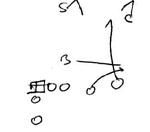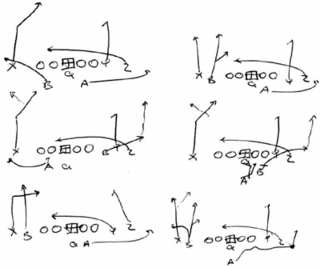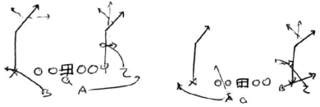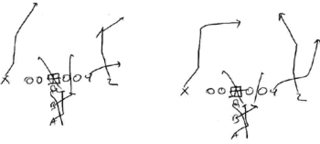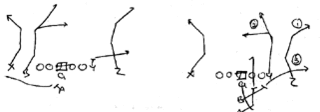Anyone who has watched
Edge NFL Matchup (the best football show on television by far) is familiar with the idea of "matchups" or "formationing". However, rarely is the concept used properly by coaches. Often, even experienced coaches will give lip service to "using multiple formations" and that, without purpose, if you run X number of plays in Y formations it somehow inherently makes you a better offense. Further, tactical substitution is even less understood. Sometimes not substituting is tactical (i.e. the wishbone or run and shoot looks the same pre-snap every play), but substitution and formationing are tools to be used by the crafty coach.
The great advantage to formations and substitution versus new plays and schemes as a tactic is that new schemes and plays require the coaches
and players to learn something new. Whereas, on the whole, a formation, once learned, can be used over and over in many different situations, and a personnel grouping only requires that other players learn certain responsibilities (which can sometimes be demanding if that player is required to learn several significantly different positions). However, the coach can pretty much substitute or throw in a new formation at will, and the players pretty much will execute their task regardless of who is in the game or what the formation is.
FormationingI will discuss this the least, since the literature and discussion of formationing is more widely available, and I think the most useful approach to this is for individual coaches to spend some time doodling it onto paper to see what can be discovered on their own.
However, this is the first tool used. Each defense has various strengths and weaknesses, and often defensive coaches, consciously or unconsciously, will often try to overcompensate for these weaknesses through personnel or tactics, so that creates further games. However, knowing these strengths and weaknesses is important for any offensive coach. For example two situations are digrammed:

On the left, the offense lines up in trips, which is troublesome for a defense that wants to play cover 2. The three frontside receivers require coverage from the undercoverage defenders, and the QB and RB can option or run the ball to either side, putting the inside linebackers in a bind. Further, with a favorable matchup, X versus the single cornerback presents different problems, particularly for slant routes. Thus the offense can kind of work a progression of frontside quick passes, strongside running to weakside running, to weakside passing, making the lives of the defenders, particularly those two inside backers, miserable.
In the diagram on the right, versus a 3 man front, vs what we would call a 3-4 strong stacked (or a 3-5 if the team uses this consistently as a base defense), we first line up in a balanced formation, seeing if the defense tries to load one side or another.
Most importantly though, with only 3 LOS defenders, we go two tight ends (we can go 2 backs and 2 tights if we truly want to be a powerful run team). First, we have six inside gaps (8 if you count off end runs) that the D must account for, and we can double team all of the LOS defenders and still have a free linemen, here the left guard, that can free release to block a second level defender. From here, as with the trips, the games would begin where we would want to run the ball, waiting until their contain defenders cheat inside or the free safety cheats up, at which time we would start throwing quick passes or passes off a run action.
Personnel and SubstitutionsWhen planning for the year, it is important to identify your "studs" or the players that can change--and win--games on their talent, ability, and drive. These can take different forms, from gamebreakers to linemen who can pancake defensive linemen to a multitalented tight end or wingback, but they must be identified.
Second, you must flesh out your O with your best 11 players. I am a firm believer than you need a strong 11 players who are your "starters" and these will be the guys that help you score points and win games. I do not have guys that just stand out to the side or linemen we don't run behind, all are expected to contribute.
Starting from this helps discipline your thinking when substituting. Coming back to your studs and your best 11 helps prevent you from substituting without purpose or for purely cosmetic reasons; if I am going to take one of my best 11 off the field then I need a damn good reason.
The Value of OpenersFirst, when designing openers I like to, almost indiscriminantly, get the ball to some of my studs. As little as it should matter, psychologically it helps them get into the flow of the game, and they approach games more seriously and confidently knowing that we have plays designed for them to get the ball early when we practice our openers.
However, we also run lots of formations, motions, and a few substitution packages to get a feel for the defense. First, this can send them scrambling to see what we've thrown at them, but, most importantly, we want to see what they do. Do they put a linebacker or a safety on this guy? Do they shift their backers over? Do they shade their DL? Different coaches watch for these adjustments and we confirm a picture about the D. The more unconventional your offense the more important this is. From my experience teams would line up in all new defenses versus us almost every week, so our weekly preparation had to be contingency based rather than definitely prescriptive.
The big question we ask during the week and seek to confirm early in the game is: "Do they substitute based on situation (down and distance) or based on offensive substitution? Is there a breaking point where they shift between one or the other?"
This is very important, because it changes our entire method of substituting. If we know they like to go nickel on 3rd and 7, then we need to anticipate the nickel personnel and maybe we want to stay in base, or maybe we MUST sub in quicker players or else our RBs and tight ends will not get open. Conversely, if they substitute based on personnel, maybe we can do a power package on 1st and 10 and they will take out their free safety who we really fear in the passing game but is a poor tackler. This will be worked on all week as well as mid-game.
Again, the great advantage of this kind of strategy is it does not require the players to learn anything new. We do like our players to be smart (I used to tell them that by the time they leave I hoped they could all be coaches), but it doesn't require extra practice time to do this kind of stuff. A new trap play does.
Walkthrough of SituationTo help highlight what I mean, I will walk through one simple situation. Let's say we are a base pro-set team, with a halfback, fullback, tight end, split end and flanker. W want to make an adjustment and line up with the halfback split out as a receiver, so we move him outside of the split end and we look to see how the defense adjusts, as diagrammed below.

First, do they cover him at all? If they play way off, we may want to throw an immediate pass to H, who is our best runner, out in space. I've called this, seen our halfback make some people miss and score a long TD. Makes you feel like a genius, but is so obvious!

Here, they play man or some kind of "up" coverage. Importantly, since the cornerback's rule is probably something along the lines of "take the widest man" then our split end, our best or second-best receiver and route runner, is now matched up with a linebacker (it could also be a safety, and this could be advantageous as well).
Let's just say that it is pleasing to look up and see one of your speedy guys being covered by someone with their number in the 50s (or up!).
Obviously here we would try to isolate our split end on this player and let him beat his man on a pass route.
In the diagrams below the defense matches up with the corner on the split end and moves the LB out. Aside from the passing game, this is helpful for the run game, as we have taken a better run defender outside. Anyway, though, we now have H matched up on the outside with a LB.

Above we show the RB versus this backer in the backfield or split out. While he can run many routes from the backfield, he is not the threat deep that he would be, and the LB has more help from his safety and other cover man inside. However, split out on the sideline, he is on an island, and must first defend against the straight go or fade route (also the easiest to teach a RB who otherwise needs to learn other responsibilities).

Lastly, if we have been successful with all of these tactics the defense may get fed up and rotate a zone over to this side. First, we realize that we still have a strong run formation strong with our tight end. Second, it is a 3 receiver side, and we can flood the zone to this side where we can achieve an advantage. Thus are the cat and mouse games of offense vs. defense.
Motion and ShiftingI will be brief here, but motioning and shifting are easily applied to the concepts shown in this article.
The first thing about motioning or shifting is that they achieve the same purposes as formationing and substitution--it is the final formation that truly matters--but they generally give the defense less time to adjust and see what you are doing.
MotionThere is lots of overlap between motioning and formationing, but here is a brief list of reasons to motion (mostly taken from Bill Walsh).
1. Create a certain mismatch
2. Force the defense into a certain coverage
3. Put a player in best position to do a job (i.e. motion a RB out to go deep)
4. Confuse the defense's responsibilities
5. Disguise the play by breaking a formation tendency
6. Give them more to think about (motion causes emotion!)
7. Force defense into revealing keys (can be misleading at times)
Do NOT use motion cosmetically. If you are just motioning to motion, because you think you should, then you are wasting time and throwing off your offensive rhythm. You are better off getting to the line and calling the play on a quick count.
The special case of orbit motion or return motion, where a player motions in, usually to the center, and then goes back out to where he was, is on its way out. At one time this was very effective for determining if the defense was in man or zone, but has become increasingly less telling, and you see it less and less at the higher levels of football. If you see value in this motion then by all means use it, but its usefulness is decreasing.
ShiftingShifting, as compared with motion has a few strengths and weaknesses. First, its strengths are that more than one player can shift at a time, and, as shown below, you can actually change the strength of a formation (which can be done with motion but not as easily or dramatically). This is maybe the most powerful adjustment at the LOS you can make.

The primary weakness of a shift is that your players must be set before the snap, giving the defense some time to adjust, while motion allows less.
ConclusionThis is the probing approach to formationing and personnel. It is not reactive in the passive sense. "Take what the defense gives you" has been changed from useful advice to a condemnation of conservative playcalling.
However, to some extent, it is still true when approaching the game tactically. This is formationing, shifting, and substituting with a purpose: intelligent strategy incorporates what the other team is doing, while staying true to your team's strengths.
Moreover, football is still a game of talent and people. If their 11 are better than yours, it probably matters little whether H is in the backfield or lined up wide as a receiver or if you shift your tight end from one side to the other. However, you look for what you can get. If you can find one personnel advantage then you can potentially trigger a structural change that can open up the rest of your offense and put your other players in position to succeed and contribute.
During a game you may have 2, 3, or 4 of these little mini-games going on. Moving this guy here, motioning that guy there, recreating the formation and doing something different, etc. A well designed and well taught offense can do these without confusing your players, putting the D in a bind. Conversely, a well designed and well taught defense can react to all these little offensive tactics and still let their players just go out there, play some football, and hit somebody.
To reiterate a running theme, football is a very simple game. The actual concepts you use, the number of ways to put 11 (or 22) pieces on the field is more finite than we think. All we can do is to teach our players as best we can during the weeks and then on gameday put them in the best position to succeed.
